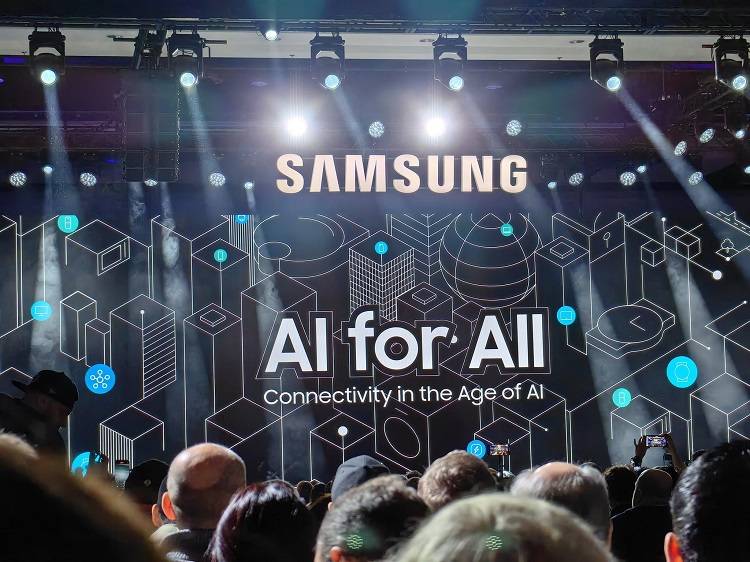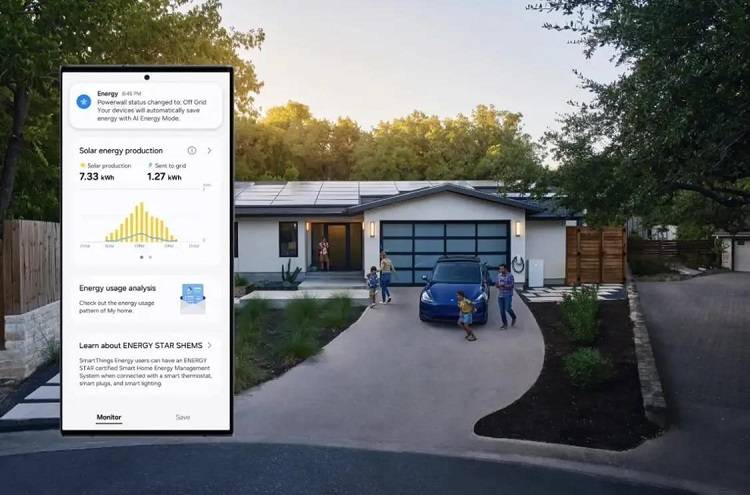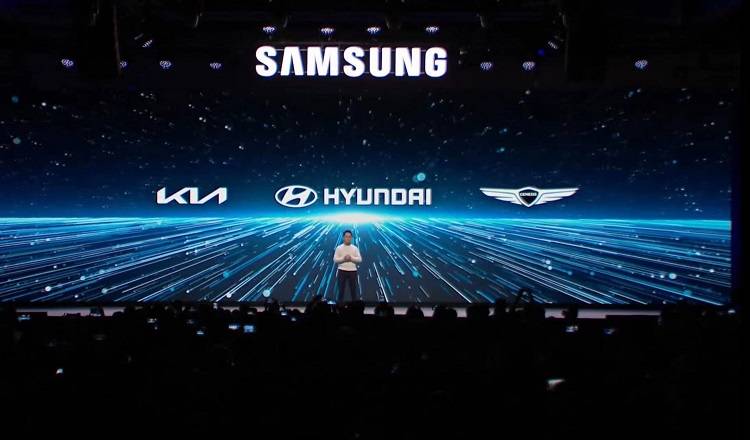 Technology peripherals
Technology peripherals
 AI
AI
 Samsung Electronics joins forces with Hyundai, Kia and Tesla to develop IoT and Powerwall
Samsung Electronics joins forces with Hyundai, Kia and Tesla to develop IoT and Powerwall
Samsung Electronics joins forces with Hyundai, Kia and Tesla to develop IoT and Powerwall
At the recent 57th U.S. Consumer Electronics Show (CES 2024), Samsung Electronics announced some exciting smart home partners, including Tesla, Hyundai Kia and Genesis. brand. This cooperation will further promote the interconnection between smart homes and cars, bringing users a more convenient smart life experience.

The much-watched cooperation between Samsung Electronics and Tesla mainly focuses on smart home and energy management. According to officials, users of Samsung’s SmartThings platform will be able to connect to products such as Tesla’s Powerwall home energy storage battery and track power generation and power usage in real time. This technology will be demonstrated at CES 2024 and is planned for large-scale launch in the second quarter of this year.

According to a live demonstration, when connected to a Tesla Powerwall battery, the Samsung SmartThings Energy energy platform can be synchronized with the Powerwall's "Storm Watch" function. This means users can receive notifications about severe weather via their Samsung phone or TV. In addition, SmartThings Energy can also be connected with other Tesla products, including cars, solar inverters and wall chargers, to monitor and switch energy status. This integration can provide users with a more convenient and intelligent energy management experience.

The cooperation between Hyundai-Kia Group and Samsung Electronics is very special. The car brand leverages Samsung's IoT platform to connect home-to-car and car-to-home services through SmartThings. Drivers can control home appliances through voice commands in the car, such as turning on the home air conditioner, sweeping robot or washing machine in advance. Similarly, you can also remotely control the vehicle at home and turn on functions such as air conditioning or seat heating in advance. In addition, you can check the vehicle status and adjust the charging time of the electric vehicle. This smart connected functionality provides drivers with a more convenient and comfortable experience.

At the latest conference, Samsung Electronics demonstrated their Ready Vision augmented reality technology. This technology applies functions that previously existed only in virtual reality glasses to cars and presents them to the driver in the form of a HUD head-up display. Compared with HUDs currently on the market, this technology integrates more functions, such as providing the fastest parking route or the address of a coffee shop. In the future, this technology may also cooperate with merchants to present more information.
The above is the detailed content of Samsung Electronics joins forces with Hyundai, Kia and Tesla to develop IoT and Powerwall. For more information, please follow other related articles on the PHP Chinese website!

Hot AI Tools

Undresser.AI Undress
AI-powered app for creating realistic nude photos

AI Clothes Remover
Online AI tool for removing clothes from photos.

Undress AI Tool
Undress images for free

Clothoff.io
AI clothes remover

Video Face Swap
Swap faces in any video effortlessly with our completely free AI face swap tool!

Hot Article

Hot Tools

Notepad++7.3.1
Easy-to-use and free code editor

SublimeText3 Chinese version
Chinese version, very easy to use

Zend Studio 13.0.1
Powerful PHP integrated development environment

Dreamweaver CS6
Visual web development tools

SublimeText3 Mac version
God-level code editing software (SublimeText3)

Hot Topics
 Sources say Samsung Electronics and SK Hynix will commercialize stacked mobile memory after 2026
Sep 03, 2024 pm 02:15 PM
Sources say Samsung Electronics and SK Hynix will commercialize stacked mobile memory after 2026
Sep 03, 2024 pm 02:15 PM
According to news from this website on September 3, Korean media etnews reported yesterday (local time) that Samsung Electronics and SK Hynix’s “HBM-like” stacked structure mobile memory products will be commercialized after 2026. Sources said that the two Korean memory giants regard stacked mobile memory as an important source of future revenue and plan to expand "HBM-like memory" to smartphones, tablets and laptops to provide power for end-side AI. According to previous reports on this site, Samsung Electronics’ product is called LPWide I/O memory, and SK Hynix calls this technology VFO. The two companies have used roughly the same technical route, which is to combine fan-out packaging and vertical channels. Samsung Electronics’ LPWide I/O memory has a bit width of 512
 Samsung announced the completion of 16-layer hybrid bonding stacking process technology verification, which is expected to be widely used in HBM4 memory
Apr 07, 2024 pm 09:19 PM
Samsung announced the completion of 16-layer hybrid bonding stacking process technology verification, which is expected to be widely used in HBM4 memory
Apr 07, 2024 pm 09:19 PM
According to the report, Samsung Electronics executive Dae Woo Kim said that at the 2024 Korean Microelectronics and Packaging Society Annual Meeting, Samsung Electronics will complete the verification of the 16-layer hybrid bonding HBM memory technology. It is reported that this technology has passed technical verification. The report also stated that this technical verification will lay the foundation for the development of the memory market in the next few years. DaeWooKim said that Samsung Electronics has successfully manufactured a 16-layer stacked HBM3 memory based on hybrid bonding technology. The memory sample works normally. In the future, the 16-layer stacked hybrid bonding technology will be used for mass production of HBM4 memory. ▲Image source TheElec, same as below. Compared with the existing bonding process, hybrid bonding does not need to add bumps between DRAM memory layers, but directly connects the upper and lower layers copper to copper.
 Samsung Electronics reiterates that the SF1.4 process is expected to be mass-produced in 2027 and plans to enter the field of co-packaging optics
Jun 13, 2024 pm 05:10 PM
Samsung Electronics reiterates that the SF1.4 process is expected to be mass-produced in 2027 and plans to enter the field of co-packaging optics
Jun 13, 2024 pm 05:10 PM
This site reported on June 13 that Samsung Electronics reiterated at the Samsung Foundry Forum 2024 North America held on June 12, local time, that its SF1.4 process is expected to be mass-produced in 2027, countering previous media rumors. Samsung said its 1.4nm process preparations are progressing smoothly and it is expected to reach mass production milestones in both performance and yield in 2027. In addition, Samsung Electronics is actively researching advanced logic process technology in the post-1.4nm era through innovations in materials and structures to realize Samsung's commitment to continuously surpass Moore's Law. Samsung Electronics simultaneously confirmed that it still plans to mass-produce the second-generation 3nm process SF3 in the second half of 2024. In the more traditional FinFET transistor segment, Samsung Electronics plans to launch S
 Samsung introduces BM1743 data center-grade SSD: equipped with v7 QLC V-NAND and supports PCIe 5.0
Jun 18, 2024 pm 04:15 PM
Samsung introduces BM1743 data center-grade SSD: equipped with v7 QLC V-NAND and supports PCIe 5.0
Jun 18, 2024 pm 04:15 PM
According to news from this website on June 18, Samsung Semiconductor recently introduced its next-generation data center-grade solid-state drive BM1743 equipped with its latest QLC flash memory (v7) on its technology blog. ▲Samsung QLC data center-grade solid-state drive BM1743 According to TrendForce in April, in the field of QLC data center-grade solid-state drives, only Samsung and Solidigm, a subsidiary of SK Hynix, had passed the enterprise customer verification at that time. Compared with the previous generation v5QLCV-NAND (note on this site: Samsung v6V-NAND does not have QLC products), Samsung v7QLCV-NAND flash memory has almost doubled the number of stacking layers, and the storage density has also been greatly improved. At the same time, the smoothness of v7QLCV-NAND
 It is reported that Intel CEO Pat Gelsinger will deliver a plenary speech at ISSCC for the first time next year to introduce foundry progress.
Aug 10, 2024 am 07:42 AM
It is reported that Intel CEO Pat Gelsinger will deliver a plenary speech at ISSCC for the first time next year to introduce foundry progress.
Aug 10, 2024 am 07:42 AM
According to news from this website on August 9, Korean media "Chosun Ilbo" reported that Intel CEO Pat Kissinger will attend the next IEEEISSCC International Solid-State Circuits Conference to be held in San Francisco from February 16th to 20th, 2025 local time. , and will deliver a keynote speech at the ISSCC plenary session for the first time. Note from this site: Speakers at the ISSCC2024 plenary session include Zhang Xiaoqiang, deputy co-chief operating officer of TSMC, etc.; at ISSCC2023, AMD CEO Su Zifeng, imec Chief Strategy Officer JoDeBoeck, etc. delivered plenary speeches. According to reports, Intel’s plenary speakers mainly introduce CPU-related technologies at the ISSCC conference, but Pat Kissinger’s speech to be released next year will focus on Intel’s I
 It is reported that Samsung Electronics V9 QLC NAND flash memory has not yet received mass production-ready license, affecting Pyeongtaek P4 factory planning
Jul 31, 2024 pm 08:38 PM
It is reported that Samsung Electronics V9 QLC NAND flash memory has not yet received mass production-ready license, affecting Pyeongtaek P4 factory planning
Jul 31, 2024 pm 08:38 PM
According to news from this site on July 31, Korean media ZDNetKorea reported that the QLC version of Samsung Electronics’ V9NAND flash memory has not yet received a mass production license, which has affected the production line construction planning of the Pyeongtaek P4 factory. Samsung Electronics announced in April this year that the 1Tb capacity TLC version of its V9NAND flash memory has achieved mass production, and the corresponding QLC version will enter mass production in the second half of this year. However, until now, Samsung Electronics has not issued a PRA (this site's note: should refer to Production Readiness Approval) mass production-ready license for V9QLCNAND flash memory. QLC flash memory with higher capacity and lower cost is currently the hot spot for AI inference server storage needs. The future of star products is unclear, making the three
 Christie: dual drive of technology + innovation brings unlimited possibilities
Apr 23, 2024 am 08:10 AM
Christie: dual drive of technology + innovation brings unlimited possibilities
Apr 23, 2024 am 08:10 AM
As a technology company driven by innovation, Christie is able to provide comprehensive solutions, rich industry experience and a complete service network in intelligent audio-visual technology. At this year's InfoCommChina, Christie brought RGB pure laser projectors, 1DLP laser projectors, LED video walls, and content management and processing solutions. At the event site, a large-scale customized outer spherical dome specially designed for astronomical displays became the focus of the scene. Christie named it "Sphere Deep Space", and the Christie M4K25RGB pure laser projector gave it "green vitality" . Mr. Sheng Xiaoqiang, senior technical service manager of the Commercial Business Department in China, said: It is not difficult to realize an outer spherical dome projection, but it can be made smaller and the color
 Samsung Electronics announced the list of partner companies in 2024: adding Tianma and CSOT India subsidiaries
Jul 03, 2024 pm 05:38 PM
Samsung Electronics announced the list of partner companies in 2024: adding Tianma and CSOT India subsidiaries
Jul 03, 2024 pm 05:38 PM
News from this website on July 3, according to thelec report, Samsung Electronics announced the list of partner companies in 2024. This list accounts for more than 80% of Samsung Electronics’ parts procurement, with a total of 113 companies, including 11 new companies, and another 11 companies were eliminated. In this list, companies such as Tianma Microelectronics Co., Ltd. have been added, and the Indian Panel Optodisplay Technology company has also been included. This company is the Indian subsidiary of China Star Optoelectronics (CSOT). But even if a company is no longer included in the list for a given year, this does not mean that the company's trading relationship with Samsung Electronics will immediately end. For example, last year was not included





